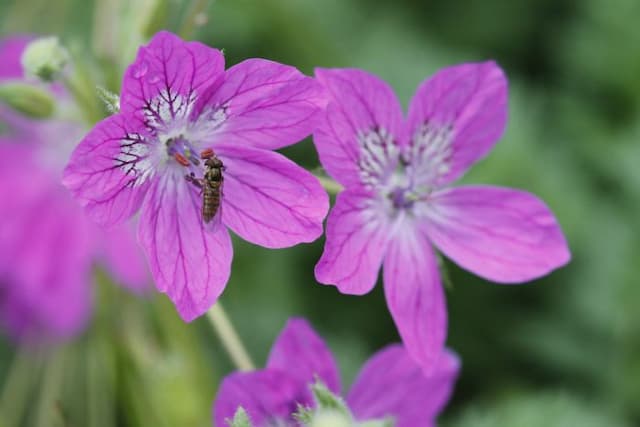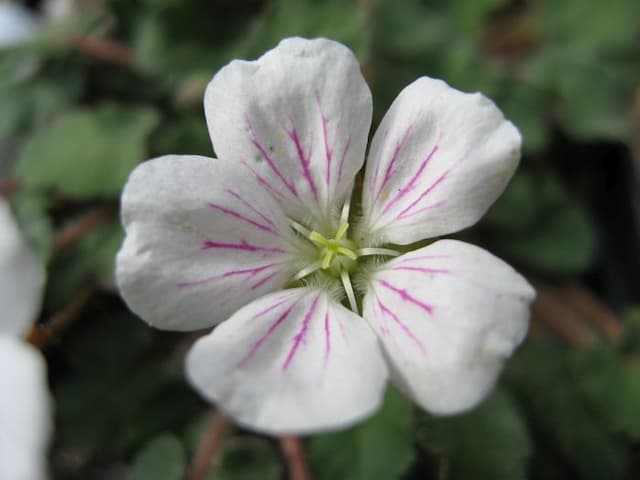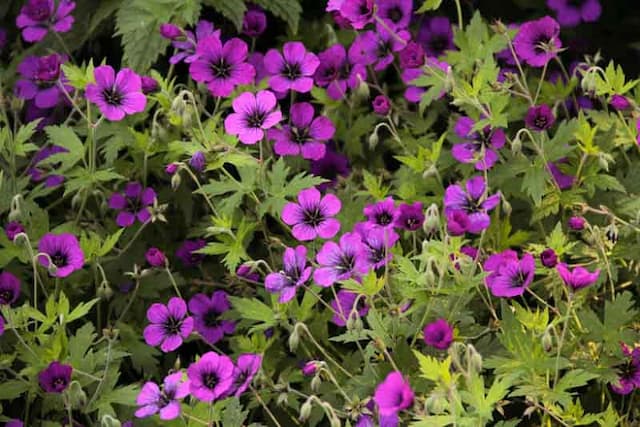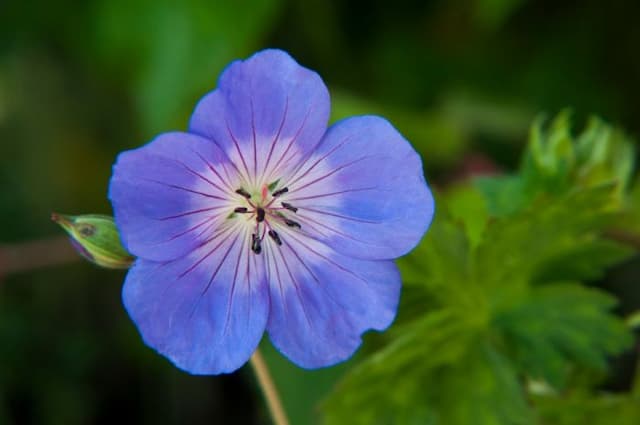Geranium Pelargonium 'The Tone' (A)

ABOUT
Pelargonium 'The Tone' (A), commonly known as a geranium, is a popular ornamental plant known for its striking appearance. The plant typically features a lush mound of deeply cut, green foliage that serves as a backdrop to its showy blossoms. The leaves are quite distinct, often with a velvety texture and may exhibit a zonal pattern, which is a darker coloration in the center, reminiscent of a horseshoe shape or a ring. The flowers of Pelargonium 'The Tone' are particularly eye-catching and are a major draw for this variety. They tend to bloom in clusters above the foliage, creating a vibrant display. Each flower within the cluster is composed of five petals, and this geranium variety often boasts petals that are beautifully colored in hues that may range from pinks to reds, often with splashes or streaks of contrasting colors that add to their overall allure. The blooms can be single or double, with double blooms resembling small, ruffled bouquets. Together, the bright flowers and the ornate leaves create a full, rounded appearance that exudes a cottage garden charm. Geranium 'The Tone' makes an excellent addition to container gardens, hanging baskets, or as a border plant in garden beds where its vivid colors and pleasant structure can be fully appreciated. It is favored not only for its aesthetics but also for its hardiness and ability to thrive in a variety of conditions.
About this plant
 Names
NamesSynonyms
Geranium, Zonal Geranium, Pelargonium, Cranesbill
Common names
Pelargonium 'The Tone'
 Toxicity
ToxicityTo humans
Geraniums are generally considered non-toxic to humans. However, ingestion of large amounts of plant material may cause mild gastrointestinal upset.
To pets
Geraniums can be toxic to pets, particularly to dogs and cats. If ingested, they may cause symptoms such as vomiting, anorexia, depression, and dermatitis. The essential oils and some other compounds in the plant are believed to be the toxic agents.
 Characteristics
CharacteristicsLife cycle
Perennials
Foliage type
Evergreen
Color of leaves
Green
Flower color
Varies
Height
1-2 feet (30-60 cm)
Spread
1-2 feet (30-60 cm)
Plant type
Herb
Hardiness zones
10
Native area
South Africa
Benefits
 General Benefits
General Benefits- Aesthetic Appeal: Adds color and visual interest to gardens or indoor spaces with its attractive foliage and blooms.
- Ease of Care: Generally an easy-to-care-for plant requiring minimal maintenance, making it suitable for gardeners of all skill levels.
- Versatility: Suitable for use in a variety of garden settings, including borders, containers, and as houseplants.
- Drought Tolerance: Once established, it has a good level of drought resistance, ideal for dry or water-scarce regions.
- Rapid Growth: Typically grows quickly, providing fast coverage and gratification in garden spaces.
- Seasonal Interest: Offers seasonal blooms that can provide periodic bursts of color throughout the growing season.
- Pest Resistance: Often resistant to many common garden pests, which reduces the need for chemical treatments.
 Medical Properties
Medical PropertiesThis plant is not used for medical purposes.
 Air-purifying Qualities
Air-purifying QualitiesThis plant is not specifically known for air purifying qualities.
 Other Uses
Other Uses- The essential oil derived from geraniums, such as Pelargonium 'The Tone', can be used in aromatherapy for creating a relaxing atmosphere and reducing stress.
- Geranium leaves can be placed in drawers or closets as a natural moth repellent to protect clothing.
- The plant can be used in the garden as a companion plant to repel insects that are harmful to vegetables and other plants.
- Geraniums can be used in culinary preparations; their flowers are edible and can add a vibrant touch to salads or as garnishes.
- The scent of geraniums can be infused into oils or vinegars to create fragrant homemade beauty products such as bath oils or skin toners.
- They can be crafted into natural potpourri by drying the leaves and flowers, which retains their strong scent and adds a decorative touch to a room.
- Geranium leaves can be used to flavor sugar by layering leaves with sugar in a jar, which is then used in teas or baking.
- The petals of geraniums can be used to create natural dyes for fabric or paper, providing a range of pink and purple hues.
- As an artistic medium, geranium leaves can be painted and pressed onto paper to make botanical prints.
- Geraniums can serve as host plants for butterfly larvae, thereby playing a role in supporting local butterfly populations.
Interesting Facts
 Feng Shui
Feng ShuiThe geranium is not used in Feng Shui practice.
 Zodiac Sign Compitability
Zodiac Sign CompitabilityThe geranium is not used in astrology practice.
 Plant Symbolism
Plant Symbolism- Health - Pelargoniums, commonly known as geraniums, are often associated with health because they have been used in traditional medicine to heal various ailments.
- Protection - Geraniums are believed to ward off negative energies and are traditionally planted in gardens or kept in homes for protection.
- Friendship - Giving a geranium as a gift may symbolize a wish for a deeper friendship or a strengthening of the bond between friends.
- Happiness - The bright and colorful flowers of the geranium are associated with happiness and a positive outlook on life.
- Fertility - In some cultures, geraniums are symbolic of fertility and abundance, making them popular in weddings and celebrations of new beginnings.
 Water
WaterGeraniums, including Pelargonium 'The Tone', should be watered thoroughly when the soil feels dry to the touch. Typically, this means watering about every 7 to 10 days, but this can vary depending on environmental conditions such as temperature and humidity. When watering, it's important to soak the soil until water runs out of the drainage holes, indicating that the moisture has reached deep enough into the pot. For an average-sized geranium growing in a 10-inch pot, you might use approximately 16-24 ounces of water. Always empty the saucer under the pot to avoid soggy conditions that can lead to root rot.
 Light
LightGeraniums prefer bright, indirect sunlight for optimal growth. Position them in a spot where they can receive at least 4 to 6 hours of sunlight daily, such as an east or west-facing window. Direct sunlight can be tolerated, especially during the cooler hours of the morning, but it's essential to protect the plants from the harsh afternoon sun that could scorch their leaves.
 Temperature
TemperatureGeraniums thrive in temperatures ranging between 55°F and 75°F. They can survive minimum temperatures around 50°F, but frost can be deadly, so they should be brought indoors if the temperature threatens to drop below that. During the summer months, temperatures should not exceed 85°F for extended periods, as excessively high temperatures can stress the plants and affect their blooming.
 Pruning
PruningPruning geraniums promotes bushier growth and encourages more blooms. Prune them in the early spring, just before the new growth begins, and again throughout the summer to remove any dead or yellowing leaves and spent flowers. Pruning can be done every 8 to 10 weeks during the growing season, cutting back leggy stems by about one-third to maintain a compact shape and to stimulate new growth for future flowering.
 Cleaning
CleaningAs needed
 Soil
SoilGeraniums (Pelargonium 'The Tone') thrive in well-draining soil with a mix of peat, perlite, and compost. Aim for a soil pH around 6.0-7.0. Good drainage is essential to prevent root rot.
 Repotting
RepottingGeraniums (Pelargonium 'The Tone') should be repotted annually in spring to encourage fresh growth and blooming. Use fresh potting mix when repotting to maintain nutrients.
 Humidity & Misting
Humidity & MistingGeraniums (Pelargonium 'The Tone') prefer moderate humidity but are quite adaptable. They perform well in average home humidity levels between 40-60%.
 Suitable locations
Suitable locationsIndoor
Place in bright, indirect light and water when soil feels dry.
Outdoor
Plant in full sun to partial shade with well-draining soil.
Hardiness zone
10-11 USDA
 Life cycle
Life cycleThe life of Pelargonium 'The Tone,' commonly known as Geranium, begins with seed germination, which requires well-drained soil and consistent warmth. Once sprouted, the seedling enters a vegetative stage, growing leaves and stems as it matures in a matter of weeks under the right conditions of sunlight and water. The plant then enters the flowering phase, producing vibrant blooms that attract pollinators, essential for the pollination process. After pollination, the flowers develop into fruit, which contains seeds for the next generation. As an annual or perennial depending on the climate, Geranium may enter a period of dormancy, especially in cooler climates, where it stops active growth and conserves energy. In the final stage of its life cycle, if conditions are not conducive to survival or after several years, the plant will die, completing the cycle.
 Propogation
PropogationPropogation time
Spring-Early Summer
Propogation: Pelargonium 'The Tone', commonly known as a type of Geranium, can be propagated most popularly through stem cuttings. This method involves taking a healthy stem from a mature plant, usually about 4 to 6 inches (approximately 10 to 15 centimeters) in length, and cutting it just below a leaf node with a clean, sharp implement. The lower leaves are removed, and the cut end can be dipped in rooting hormone to encourage root development. The cutting is then planted in a pot filled with a moist, well-draining potting mix. To provide the ideal environment for rooting, maintain the soil's moisture without making it soggy and keep the cutting in a warm area with indirect sunlight until new growth indicates that the roots have established, which typically takes a few weeks.







![Cranesbill [Rothbury Gem]](/_next/image?url=https%3A%2F%2Fplants-admin.emdemapps.com%2Fimages%2Fplants%2F%2Fimages%2F604b6243984c2.png&w=640&q=75)

